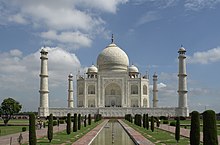Shah Jahan period architecture
This article needs additional citations for verification. (January 2020) |
Shah Jahan's architectural style of the building in South Asia flourished during the era of Mughal emperor Shah Jahan. Taj Mahal in Agra, India is a prime example of this type of architecture. architecture of this era is marked by symmetry and balance between the parts of the building, with white marble become the primary choice of building materials.
Another example of Shah Jahan period architecture found in the Red Fort in Delhi, India. "Hall of Public Audience" and "Hall of Private Audience", which housed the Peacock Throne, are more examples of the architecture of this period. Another example is Shah Jahan Mosque, Thatta in Pakistan.
Under the reign of Shah Jahan, however, there is an emphasis unprecedented in Mughal architecture in a graceful line structure and a harmonious balance between all the parts. Shah Jahan's personal involvement in architecture and urban planning appears to have motivated others, especially high-ranking ladies of the court, to build.
Red Fort
Shah Jhan also built Red Fort at Delhi .The construction of Fort was start in 1639 and completed in 1648.
References[]
- Encyclopædia Britannica, 1988, volume 10, p. 687
- Mughal architecture
- Architectural style stubs

